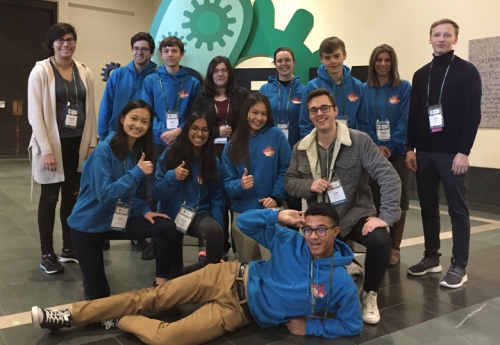The University of Lethbridge’s Collegiate iGEM team set its sights on solving a problem that affects nearly nine per cent of the world’s population, and earned a gold medal for their efforts at the recently concluded International Genetically Engineered Machines World Jamboree in Boston, MA.
The collegiate team, accompanied by the U of L’s High School iGEM entry that achieved a silver medal standing for its project, presented Algulin, which is the development of a novel method for the manufacturing and oral delivery of insulin to diabetics.

“We wanted to do something different and meaningful, something that will have a positive effect on the people around us,” says Dia Koupantsis, a third-year biological sciences student. “So, we developed the project Algulin, an oral insulin manufactured in microalgae, in an attempt to democratize the manufacturing of insulin so that it can be widely available for individuals who need it.”
Diabetes is a massive global issue that requires lifelong management for those affected, imposing an enormous economic health burden that amounts to a $673 billion global expenditure annually. Currently, the most common method of relieving diabetes symptoms is through painful, expensive insulin injections. Some patients must self-administer the drug up to six times per day.
After interviewing diabetic patients, doctors and pharmacists, the iGEM team went about trying to find a way to deliver insulin to patients orally. The challenge, which has thwarted previous attempts, is to find a way to get the insulin through the stomach acid and into the small intestine for absorption without becoming seriously degraded. Their solution – microalgae.
Algulin is an oral insulin produced in microalgae. After testing three different microalgae, the group determined Cyanidioschyzon merolae, with its innate acid resistant membrane, could survive the stomach environment. Additionally, with a carbohydrate-based cell wall, C. merolae would degrade in the small intestine and allow for the therapeutic insulin to be absorbed through to its intended target — the portal vein.
“It was a challenging project because it involved working with an organism we’d never used before,” says Luke Saville, a fourth-year biochemistry student. “This promoted challenges in learning how to grow the organism and how to genetically engineer it to produce our insulin.”
U of L chemistry & biochemistry instructor Dr. Angeliki Pantazi is one of the team’s faculty mentors and lauds the team for the work they put in and the further potential of their project.
“The gold medal is exciting but it’s a little bit less about what we came back with and more about how we are training the next generation of scientists and leaders through these programs,” she says. “It’s a very student-driven program and I was impressed with why they wanted to pursue this project. They were concerned about people not being able to afford insulin and inspired by the first two Canadian scientists who isolated purified insulin and how they didn’t patent it for themselves but instead offered it to humankind for free.”
Now that the iGEM season is over, it’s up to the group to find possible investors to continue their work and eventually try and get a product to market. The next stage would be performing animal studies to see how the insulin is being transferred into the bloodstream and how it functions.
“I think it has great commercial potential,” says Saville. “By moving away from injectables and purification free insulin growth, we can dramatically lower the cost of diabetes management while providing a more comfortable way to administer medicine.”
Other members of the collegiate team included: Catrione Lee, Kalob Barr, Jesse Holbein, Allyson Lawrie-White, Landon McCabe, Joshua Omotosho, Kera Whitten and Dong Ju Kim. Graduate student advisors included Sydnee Calhoun, Aubrey Demchuk, Chris Isaac and Kristi Turton while Dr. Trushar Patel (chemistry & biochemistry) was the secondary investigator.
High school team earns silver
All four local high schools contributed to the team that presented CADAR (CRISPR assisted detection and removal) at the World Jamboree, a project designed to create a rapid diagnostic tool for identifying bacterial pathogens.
“Our team decided to choose CADAR because we saw the increasing prevalence of antibiotic resistance in pathogenic bacteria,” says Mark Lea, a Chinook High School graduate who is now in his first year at the U of L. “We found, through initial research, that there is a lot of over-prescription of antibiotics that further increases the amount of bacterial resistance. We thought finding an alternative and more novel approach to traditional antibiotic methods of identifying and then eliminating those pathogens would be an interesting project.”
Dr. Laura Keffer-Wilkes, the manager of Synbridge and high school team advisor, says the project was very ambitious for the high school group and she was pleased with the work they put in to try and develop a product that could be used in health care and patient care settings, in processing plants and even ambulances as a means to validate cleaning practices.
“It’s really student-driven, so they go after whatever motivates them, whatever passions they have,” she says. “As a high school instructor, I don’t want to stifle their creativity, and they used some very advanced technology in their work.”
The high school team consisted of: Alice Zhang, Andy Sun, Aroma Pageni, David Basil, Dewuni De Silva, Elisha Wong, Julien Todd, Karen He, Linda He, Katie Vienneau, Mark Lea, Michelle Wu, Mina Akbary, Natasha Woitte, Rachel Avileli, Rebecca Avileli, Shada Aborawi and Thomas Byrne.
For more on iGEM culture at the U of L, check out this UNews story.
To view online: https://www.uleth.ca/unews/article/university-lethbridge-igem-team-earns-gold-project-designs-oral-insulin-delivery-system
Group photo of collegiate and high school iGEM teams and their advisors. Back row (L–R) Catrione Lee, David Basil, Mark Lea, Dia Koupantsis, Laura Keffer-Wilkes, Thomas Byrne, Angeliki Pantazi, Chris Isaac. Middle kneeling (L–R) Linda He, Dewuni De Silva, Michelle Wu, Luke Saville. Front – Julien Todd.
-- 30 --
Contact:
Trevor Kenney, News & Information Manager
403-329-2710
403-360-7639 (cell)
trevor.kenney@uleth.ca
@ULethbridgeNews
Dr. Angeliki Pantazi, Department of Chemistry & Biochemistry
403-329-2349
angeliki.pantazi@uleth.ca